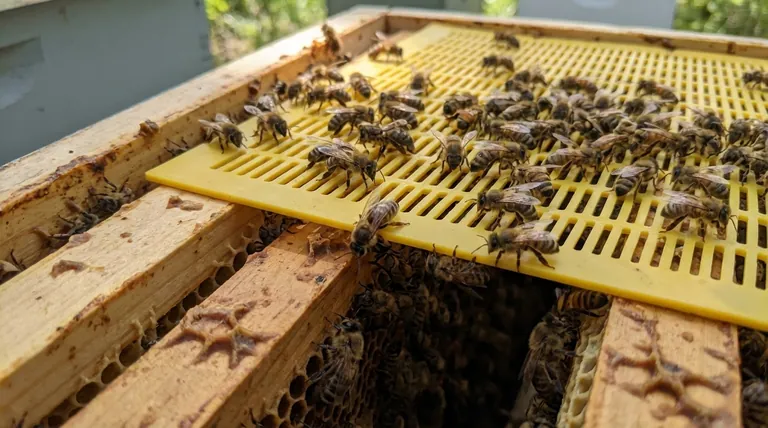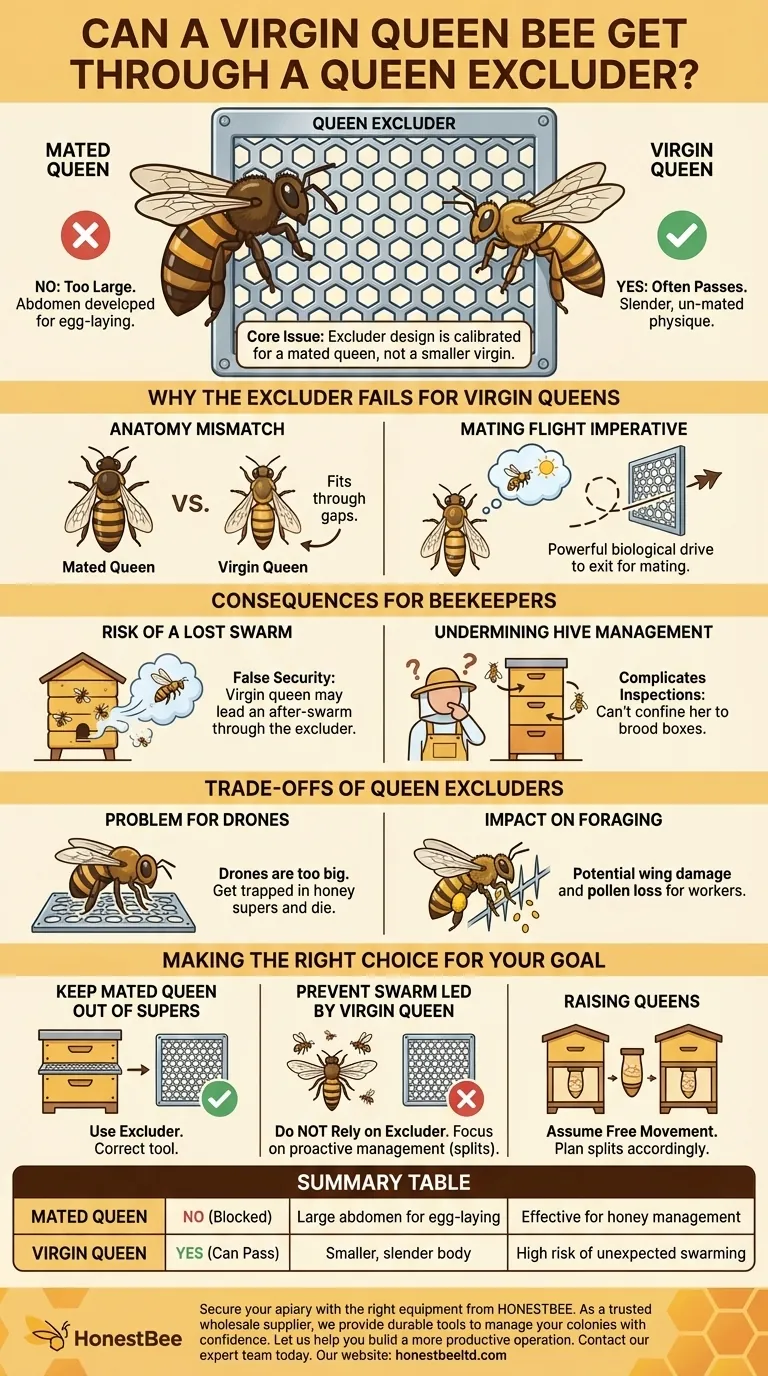Yes, a virgin queen can often get through a queen excluder. While an excluder is designed to block a larger, mated queen, a virgin queen is significantly smaller and more slender. Her abdomen has not yet developed for egg-laying, allowing her to squeeze through the gaps that would normally contain a mature queen.
The core issue is a mismatch between the tool's design and the queen's life stage. A queen excluder is calibrated for the size of a mated, laying queen, making it an unreliable barrier for containing a smaller, un-mated virgin queen.

Why the Excluder Fails for Virgin Queens
A queen excluder works on a simple principle of size. The gaps are wide enough for worker bees to pass through but too narrow for a mature queen and drones. However, this design has a critical exception.
The Anatomy of a Mated vs. Virgin Queen
A mated, laying queen has a large, elongated abdomen necessary for producing thousands of eggs per day. It is this developed abdomen, along with a larger thorax, that prevents her from passing through the excluder.
A virgin queen, by contrast, has not yet mated and is not laying eggs. Her physical profile is much closer to that of a large worker bee, making it possible for her to slip through the grid.
The Mating Flight Imperative
A virgin queen's primary biological drive is to leave the hive for her mating flight. This powerful instinct means she will actively seek an exit. An excluder is simply an obstacle she is physically capable of overcoming.
The Practical Consequences for Beekeepers
This physical reality creates significant challenges in hive management, particularly during swarm season. Relying on an excluder to contain a virgin queen can lead to a false sense of security.
The Risk of a Lost Swarm
If the colony is preparing to swarm with a virgin queen (often as a secondary or "after-swarm"), she can exit through the excluder with a portion of the bees. The beekeeper may believe the hive is secure, only to lose a significant part of the workforce.
Undermining Hive Management
One of the main uses for an excluder is to confine the queen to specific brood boxes, making her easier to find. If a virgin queen can move freely throughout the hive, this benefit is lost, complicating inspections and requeening efforts.
Understanding the Trade-offs of Queen Excluders
While useful for honey production, queen excluders are not without their downsides. It's important to recognize their limitations and effects on the colony as a whole.
The Problem for Drones
Drones are larger than worker bees and cannot pass through an excluder. If they emerge in a honey super above an excluder, they are trapped. Unable to leave the hive for mating flights or return to the brood nest, they will eventually die.
Potential Impact on Foraging
Some evidence suggests that the sharp edges of a metal excluder can damage workers' wings over time. Workers may also scrape pollen from their legs as they squeeze through, slightly reducing the efficiency of pollen collection.
Making the Right Choice for Your Goal
Using a queen excluder effectively means aligning its use with a specific, realistic goal.
- If your primary focus is keeping a mated queen out of honey supers: An excluder is the correct tool for this job.
- If your primary focus is preventing a swarm led by a virgin queen: Do not rely on an excluder. Your strategy should focus on proactive swarm management, such as splitting the hive or managing swarm cells.
- If your primary focus is raising queens: Assume any virgin queen can move freely throughout the hive and plan your nucleus colonies and splits accordingly.
Ultimately, recognizing that a queen excluder is a specialized tool for a mated queen is essential for managing your hives with confidence and preventing unexpected swarms.
Summary Table:
| Queen Type | Can Pass Through Excluder? | Reason | Key Risk for Beekeeper |
|---|---|---|---|
| Mated Queen | No | Larger, egg-laying abdomen is too big for the gaps. | Effective for honey super management. |
| Virgin Queen | Yes | Smaller, slender abdomen similar to a large worker bee. | High risk of unexpected swarming and lost bees. |
Secure your apiary with the right equipment from HONESTBEE.
Managing swarms and ensuring hive health requires reliable tools. As a trusted wholesale supplier for commercial apiaries and beekeeping equipment distributors, HONESTBEE provides the durable, effective supplies you need to manage your colonies with confidence.
Let us help you build a more productive and secure operation. Contact our expert team today to discuss your wholesale needs and discover how our products support your success.
Visual Guide

Related Products
- Professional Plastic Queen Excluder for Modern Beekeeping
- Wooden Queen Bee Excluder for Beekeeping
- High Performance Plastic Queen Excluder for Beekeeping and Apiary Management
- Premium Wood Framed Metal Wire Queen Bee Excluder
- Plastic Queen Bee Excluder for Bee Hive Wholesale
People Also Ask
- What are the pros of using a queen excluder? Boost Hive Control & Honey Quality
- What is the primary function of a queen excluder in beekeeping? Control Hive Layout for Efficient Honey Harvesting
- What is the role of a queen excluder when adding a super? Ensure Brood-Free Honey Harvests
- How does a queen excluder work? Master Hive Management for Pure Honey Harvests
- Why are queen excluders recommended for Flow Hives? Prevent Brood Damage for a Clean Harvest



















